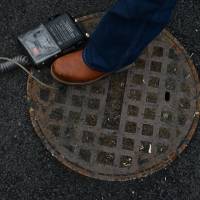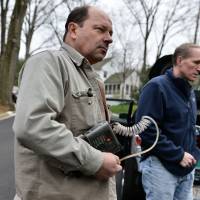Two guys in a black car cruise the streets of Washington's residential neighborhoods. The only signs of what they are up to are a gray plastic tube hanging out of the trunk and the fact that they get out of the car frequently to place a black box on manhole covers and study its readings.
Measuring how much methane gas is leaking from pipes under the District of Columbia could help answer a key policy question. As the production of natural gas expands in the United States and elsewhere, do its dangers for the climate far outweigh its benefits?
Methane, the main component of natural gas, is about 25 times more powerful as a heat-trapping gas than carbon dioxide, the largest human contributor to climate change; the atmospheric concentration of methane has doubled since the start of the Industrial Revolution.
While it largely dissipates in a few decades and there is far less of it in the atmosphere than carbon dioxide, it continues to drive global warming. Depending on how much leaks out in the journey from wellhead to homes and factories, some experts say, it could be enough to offset the advantages natural gas has over coal.
"We don't have enough data to develop sound policy going forward," said Steven Hamburg, chief scientist of the advocacy group Environmental Defense Fund. He noted that natural gas has a complex supply chain with "different geographies and geologies" along the way.
Hamburg is spearheading a $10 million, two-year effort to measure methane emissions along America's supply chain. As activists and energy executives debate the natural gas industry's impact and the Environmental Protection Agency weighs whether to impose new regulations, Hamburg said, "it's critically important" that America develop a better data set on methane leaks.
The group has brought together academics, environmentalists and industry representatives to track different stages of natural gas extraction, production and transmission and will issue its initial report in May.
Other teams are also working to unlock the puzzle.
Bob Ackley spent January driving the city for 10 to 12 hours a day, usually with a researcher riding alongside. Ackley, who runs a methane detection company, is part of a six-person group financed by Duke University's Nicholas School of the Environment that has collected data on thousands of methane leaks under Washington's roads.
On a recent trip through the city, Ackley took the wheel while Duke professor Robert Jackson tracked real-time methane concentrations that an instrument stashed in the car's trunk fed into a computer. Periodically the readings would spike to unsafe levels, with methane escaping from a single manhole making up as much as 32 percent of an air sample.
Last fall, the team published the results of a similar survey of Boston, which showed the city's aging infrastructure had 3,356 leaks. "Washington is at least as leaky as Boston, if not more," Jackson said. "It looks like it has both more leaks and bigger leaks than Boston."
Researchers disagree about how much methane is leaking into the atmosphere.
Cornell University's Robert Howarth has estimated somewhere between 3.6 percent and 7.9 percent of methane escapes during the production life cycle of shale gas; the Massachusetts Institute of Technology countered with a study saying it is just a fraction of that amount.
University of Colorado research scientist Gabrielle Petron, who also works in the National Oceanic and Atmospheric Administration's global monitoring division, said the rate of increasing atmospheric methane concentrations has accelerated tenfold since 2007. She said it will take a few more years to determine whether the natural gas boom helps explain the change.
"All we've done now are snapshot measurements," she said.
Their findings have major safety and environmental implications. Gas leaks contribute to smog and can lead to explosions and fires, including the one that leveled a restaurant in Kansas City, Missouri, on Feb. 19, or the 2010 pipeline explosion in San Bruno, California, that killed more than half a dozen people.
And leaking gas can also weaken and kill trees in urban areas by replacing oxygen in their roots and drying them out; Ackley has helped organize a lawsuit by five communities surrounding Boston against the region's gas company, National Grid, and he is consulting with residents of Montgomery County, Maryland, who are concerned about tree deaths there.
National Grid spokesman David Graves said that while his company has addressed individual tree deaths, "There is no evidence to support the claim that underground gas leaks cause widespread damage in vegetation."
While aging infrastructure contributes to leaks, so does the fact that utilities in Boston and D.C. can pass on the full cost of unaccounted losses — whether through leaks or theft — to customers. In Washington, this charge makes up 3 percent of Washington Gas customers' monthly costs; in Boston it represents 1 percent of residents' monthly bill, the companies say.
Phillips said gas exploration will not have to expand so rapidly if people do not waste our current supply: "Our pipeline infrastructure is leaking out resources."
Company representatives in both cities said they respond immediately to any leak reported by the public. Companies include chemical additives to give the odorless gas a distinctive scent.
"We respond to and repair leaks seven days a week, 24 hours a day, 365 days a year," Eric Grant, Washington Gas vice president for corporate relations, said in a statement. "With over 12,800 miles (20,500 km) of distribution mains in our system it is not realistic to ever state that there are no leaks in our gas pipe system."
Betty Ann Kane, who chairs the D.C. Public Service Commission, said the commission is considering a rate increase that will include a major pipe replacement initiative. "We recognize it's an old system, and the replacement of old cast iron pipes is an issue in the rate case before us," she said.
States such as Massachusetts have a mix of cast iron, unprotected steel and plastic pipe. Graves said that over the past two years, his company has replaced almost 300 miles (500 km) of leak-prone pipe throughout the state.
Doug Hock, a spokesman for Encana Oil & Gas USA, said his company and others have made major strides in cutting leaks. In 2010, Encana put an inspection and maintenance program with infrared cameras in Wyoming's Jonah Field, Hock said, reducing methane emissions by more than 80 percent.


















With your current subscription plan you can comment on stories. However, before writing your first comment, please create a display name in the Profile section of your subscriber account page.